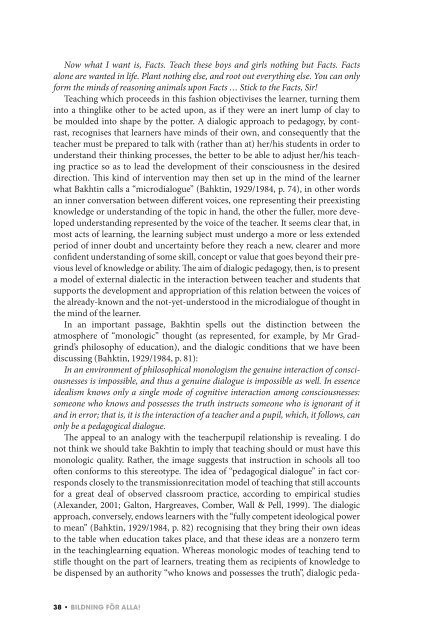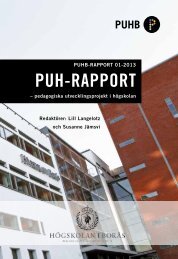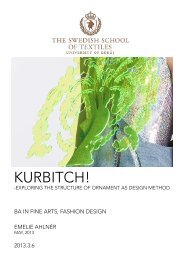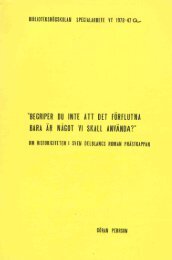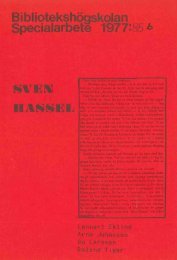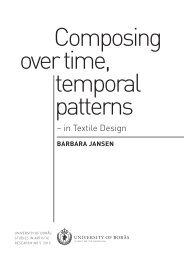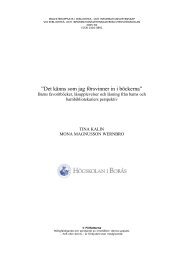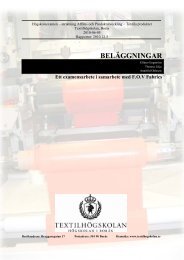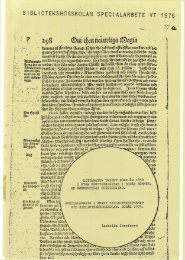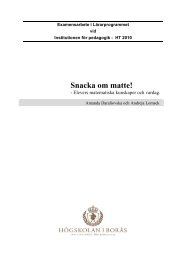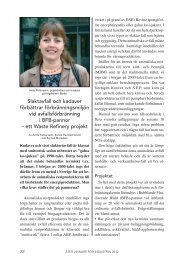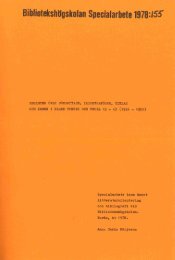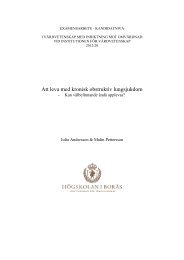Bildning för alla! - DiVA
Bildning för alla! - DiVA
Bildning för alla! - DiVA
You also want an ePaper? Increase the reach of your titles
YUMPU automatically turns print PDFs into web optimized ePapers that Google loves.
Now what I want is, Facts. Teach these boys and girls nothing but Facts. Facts<br />
alone are wanted in life. Plant nothing else, and root out everything else. You can only<br />
form the minds of reasoning animals upon Facts … Stick to the Facts, Sir!<br />
Teaching which proceeds in this fashion objectivises the learner, turning them<br />
into a thinglike other to be acted upon, as if they were an inert lump of clay to<br />
be moulded into shape by the potter. A dialogic approach to pedagogy, by contrast,<br />
recognises that learners have minds of their own, and consequently that the<br />
teacher must be prepared to talk with (rather than at) her/his students in order to<br />
understand their thinking processes, the better to be able to adjust her/his teaching<br />
practice so as to lead the development of their consciousness in the desired<br />
direction. This kind of intervention may then set up in the mind of the learner<br />
what Bakhtin calls a “microdialogue” (Bahktin, 1929/1984, p. 74), in other words<br />
an inner conversation between different voices, one representing their preexisting<br />
knowledge or understanding of the topic in hand, the other the fuller, more developed<br />
understanding represented by the voice of the teacher. It seems clear that, in<br />
most acts of learning, the learning subject must undergo a more or less extended<br />
period of inner doubt and uncertainty before they reach a new, clearer and more<br />
confident understanding of some skill, concept or value that goes beyond their previous<br />
level of knowledge or ability. The aim of dialogic pedagogy, then, is to present<br />
a model of external dialectic in the interaction between teacher and students that<br />
supports the development and appropriation of this relation between the voices of<br />
the already-known and the not-yet-understood in the microdialogue of thought in<br />
the mind of the learner.<br />
In an important passage, Bakhtin spells out the distinction between the<br />
atmosphere of “monologic” thought (as represented, for example, by Mr Gradgrind’s<br />
philosophy of education), and the dialogic conditions that we have been<br />
discussing (Bahktin, 1929/1984, p. 81):<br />
In an environment of philosophical monologism the genuine interaction of consciousnesses<br />
is impossible, and thus a genuine dialogue is impossible as well. In essence<br />
idealism knows only a single mode of cognitive interaction among consciousnesses:<br />
someone who knows and possesses the truth instructs someone who is ignorant of it<br />
and in error; that is, it is the interaction of a teacher and a pupil, which, it follows, can<br />
only be a pedagogical dialogue.<br />
The appeal to an analogy with the teacherpupil relationship is revealing. I do<br />
not think we should take Bakhtin to imply that teaching should or must have this<br />
monologic quality. Rather, the image suggests that instruction in schools all too<br />
often conforms to this stereotype. The idea of “pedagogical dialogue” in fact corresponds<br />
closely to the transmissionrecitation model of teaching that still accounts<br />
for a great deal of observed classroom practice, according to empirical studies<br />
(Alexander, 2001; Galton, Hargreaves, Comber, Wall & Pell, 1999). The dialogic<br />
approach, conversely, endows learners with the “fully competent ideological power<br />
to mean” (Bahktin, 1929/1984, p. 82) recognising that they bring their own ideas<br />
to the table when education takes place, and that these ideas are a nonzero term<br />
in the teachinglearning equation. Whereas monologic modes of teaching tend to<br />
stifle thought on the part of learners, treating them as recipients of knowledge to<br />
be dispensed by an authority “who knows and possesses the truth”, dialogic peda-<br />
38 • BilDning fÖr AllA!


